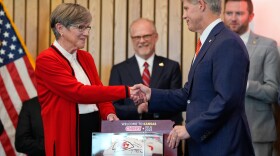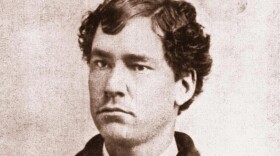KANSAS CITY, Missouri – Squeezing into the stifling costume of a professional sports mascot can make you lose 10 pounds in a half hour.
So just imagine jumping around in one — skipping across the field, dashing up stadium steps, dancing to delight the kids — on a summer day from well before the first pitch through the final out. And imagine pulling off that act in a form-fitting, six-foot, nine-inch lion’s costume topped by a giant crowned head.
“It’s like putting on leggings, then a Spandex shirt, then pajamas and then a snowsuit and then you have to be able to dance and be entertaining,” said Brad Collins, the man inside Sluggerrr, the mascot of the Kansas City Royals.
Sweat be damned, Collins said he and others in the small fraternity of professional sports mascots consider it a dream job.
“It’s what I always wanted to do,” he said.
Like the players, the men and women who make it to the show as mascots often start in college and work their way up through the minors.
Those who get there form a select, tight-knit group. They talk frequently. Get together in the off-season. And steal gags from one another.
There are only 27 full-time mascot jobs in Major League Baseball. Three teams — the New York Yankees, the Los Angeles Dodgers and the LA Angels — don’t have them.
Professional mascots can earn well into six figures. Sluggerrr’s salary isn’t public but his going rate for public appearances is $400 an hour.

On a recent Sunday, several of Sluggerrr’s fellow mascots showed up at Kauffman Stadium to help him celebrate the 25th anniversary of his debut. Fredbird, the mascot of the opposing St. Louis Cardinals was there. So were the Oriole Bird, Clark the Cub, Blooper of the Atlanta Braves, and Dinger, the mascot of the Colorado Rockies.
Kansas City Chiefs mascot KC Wolf also joined the celebration.
While waiting in a tunnel to take the field and perform, they bantered and compared costumes. Decked out in a purple dinosaur suit, Dinger sidled up to Clark the Cub to ask whether the hat sitting backward atop his bear costume could be reversed.
It works both ways, Clark said as Dinger nodded his approval.
Costumes can also be a slight source of envy in the mascot world. It’s easier, Collins said, for someone wearing a fuzzy green costume with a big belly, neon nose and googly eyes to get laughs than it is for him in a muscular lion’s suit.
“Those (cartoon-like characters) can just walk and it’s funny,” he said. “The more buff characters, we have to work harder. But it’s helped me evolve my skill set.”

Sparty to Sluggerrr
Collins spent three years at Michigan State University as Sparty, the school’s Spartan-warrior Mascot. After he graduated, he got a break that helped him go pro. He caught the eye of Dave Raymond, the original Phillie Phanatic. The guy in the big-snouted, Muppet-inspired costume started the trend toward professional mascots in the 1970s.
By the time Collins was looking for a job, Raymond had hung up his suit and started a mascot development company. He hired Collins as J.J. Jumper, the cartoon-like frog mascot of NCAA basketball.
Raymond then helped Collins get into baseball’s minor leagues. First, he was Sherman the Shorebird for the Class A team in Salisbury, Maryland. Then he became Parker T. Bear for the AAA Fresno Grizzlies in California.
Collins learned the professional mascot trade from the ground up at those stops. He performed, ordered the promotional bobbleheads, spearheaded community outreach programs, even helped roll out the tarp when it rained.
It was “hard work and long hours,” Collins said, “but I wouldn’t trade that experience because you learn everything.”
As Parker T. Bear, Collins was the face of a campaign that rewarded kids with free tickets for reading 10 books in five weeks.
“We reached thousands and thousands of kids with our literacy program,” he said.
Collins even wrote two books as Parker that became favorites in Fresno school libraries.
In Kansas City, Collins’ outreach efforts include an anti-bullying campaign.
It’s been 21 years since Collins first donned a professional mascot’s costume. He’s been with the Royals for 11 of those years.
When he started, Collins thought he’d probably have to look for another line of work when he turned 40.
“(But) I’m still having fun,” he said.”This is a special opportunity.”
Mascot reliever
The Royals make it easier for Collins to survive the long season by employing a back-up, someone to work the second game of doubleheaders and do some personal appearances.
The backup job is perfect for Phil Bennett. He’s a strategic planner for Commerce Bank who caught the mascot bug as a graduate student at the University of Kansas. At a basketball game in Allen Fieldhouse, Big Jay, the KU mascot, hoisted a sign to the crowd that read “do you want to fill these boots?” Bennett decided that he did and signed up for auditions.
“The next thing I knew, I was Big Jay,” he said. “That’s what got me hooked.”
Bennett started as Sluggerrr’s understudy in 2016 shortly after the Royals won the World Series.
“There was a ton of excitement,” he said.
The team was fielding hundreds of requests for Sluggerrr to appear at events. In addition to the usual parades and birthday parties, Bennett said, some brides requested that Sluggerrr walk them down the aisle.
On the day of Sluggerrr’s birthday bash, Bennett wore a headset so that he could communicate with Collins and guide him and his mascot friends around the stadium. He also managed the kids who lined up behind the left-field stands in the fifth inning to get their pictures taken with Slugger and wish him a happy birthday.

Interacting with young fans is one of Bennett’s favorite things about the job. But he lives for those occasions when he gets to put on the Sluggerrr suit and perform.
“It’s that rush of excitement, that adrenaline you get,” he said. “Whether that stage is a small elementary school or Kauffman Stadium, you put 100% into it.”
Having a backup is an indication of the value the Royals see in Sluggerrr, Collins said.
“Smart teams get it,” he said. “Name me another brand extension that is available to be in the community 365 days a year. You can’t put a number on that.”
Forbes magazine tried in 2016, ranking all major league mascots based on merchandise sales, social media followers and other marketing metrics. Sluggerrr came in at number three, behind only the Philly Phanatic and Mr. Met, the mascot of the New York Mets.
Sluggerrr is also enshrined in the Mascot Hall of Fame, in Whiting, Indiana, a town of about 5,000 on the shores of Lake Michigan.
The occasional relief that Bennett provides helps Collins maintain his energy during the Royals' 81-game home season.
“Sometimes when you see us out there it’s the 13th day in a row of wearing the costume in the heat and humidity and trying to be funny,” he said. “You have to really love the grind to be in baseball because, physically, for a mascot, it’s the hardest sport.”
Jim McLean is the senior correspondent for the Kansas News Service. You can reach him on Twitter @jmcleanks or email jim (at) kcur (dot) org.
The Kansas News Service is a collaboration of KCUR, Kansas Public Radio, KMUW and High Plains Public Radio focused on health, the social determinants of health and their connection to public policy.
Kansas News Service stories and photos may be republished by news media at no cost with proper attribution and a link to ksnewsservice.org.
Copyright 2021 KCUR 89.3. To see more, visit KCUR 89.3.








